Author

Overfishing: A Current Serious Environmental Problem
1. Introduction
Change in society’s lifestyle, the development of Urbanization, excess consumption and waste of human, make our planet struggle and face every day drastic effects on certain ecologies and biospheres.
Nowadays, the increase of world population that is demanding more seafood and fish than ever creates a serious and global concern which is the unsustainable fishing that results in overfishing. Overfishing is a relatively new phenomenon, that makes our oceans under pressure to meet the needs of growing populations in developing countries and a growing appetite for fish and seafood in developed nations.
Today, the rapid and modern development in fishing technology such as the massive factory ships, global positioning systems (GPS), and techniques that allow ships to deploy hooks and nets at tremendous depths make it easy to capture more fish and put the fish stock in decline. Actually, nearly 90% of the world fish population are fully exploited, overexploited or depleted (YPTE, 2020).
Fisheries is obviously a major part of the global economy. Over 15% of the blue economy sector is represented by the fisheries sector which contributes to nearly 60 million jobs globally (FAO, 2018). Additionally, fish provide the primary, consistent source of protein consumed, for nearly 50% of the world’s population (FAO, 2018).
In recent years, the global consequences of overfishing have been the focus of scientists, economists, and policymakers. Overfishing is a contemporary issue that will continue and will cause fishless oceans by 2048 if humans keep fishing at the current pace (David Marinell, 2018).
Overfishing is not only affecting the simple status of fish populations and economic viability of fisheries but it also results in much broader impacts on global food security, social stability, cultural survival, and even national security (J.L. Blanchard et al., 2017).
2. Fish consumption worldwide
Over the past 50 years, the production of fish and seafood has quadrupled worldwide due to the increase of world population thus to the food demand.
Actually, the consumption of seafood has doubled compared to the last century. This has increased pressure on fish stocks across the world.
Fish consumption increased considerably from 5.2 kg per capita in 1961 to 19.4 kg in 2017, at an average annual rate of 2.4%. This rate has increased significantly in the last 20 years, reaching 2.9 percent per year, because of expanding fish production and imports.
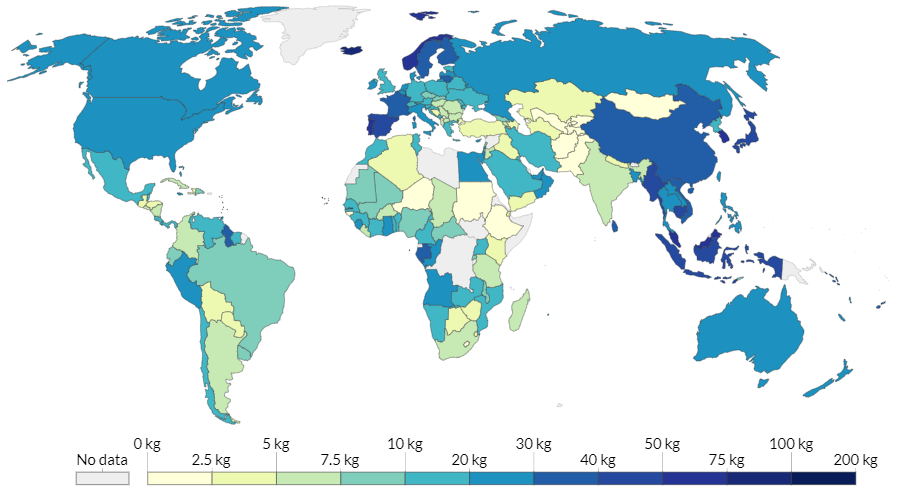
Figure 1: Fish and seafood consumption per capita, 2017 (FAO, 2020)
Table 1: Total and per capita apparent fish consumption by region and economic grouping, 2017 (Marwaha, et al., 2020)
Region | Total food fish consumption (million tonnes live weight equivalent) | Per capita food fish consumption (kg/year) |
World | 152.9 | 20.3 |
Africa | 12.4 | 9.9 |
North America | 8.1 | 22.4 |
Latin America and the Caribbean | 6.7 | 10.5 |
Asia | 108.7 | 24.1 |
Europe | 16.1 | 21.6 |
In 2017, the first fish-consuming continent is Asia with 71% of total food fish consumption. In particular, China accounted for 36% of the food fish consumption in Asia. The Americas consumed 10 percent of the total food fish supply, followed by Africa with 8 percent.
In 2017, Per capita fish consumption in Latin America and Africa has also been increasing faster than the large traditional markets in the same period. Meanwhile, per capita fish consumption in Europe and North America has been increasing by less than 1 percent (0.8 percent and 0.9 percent, respectively), while it has decreased by 0.2 percent per year in Japan.
At the regional and continental levels, the lowest per capita fish consumption occurs in Africa, where it peaked at 10.5 kg in 2014 and then declined to 9.9 kg in 2017.
Projection of the consumption
Globally, in most of the regions, the annual per capita food fish consumption is projected to decrease slightly. However, there are remarkable differences between regions as figure 2 below shows.
FAO Global Perspectives Studies on simulations with GAPS model.
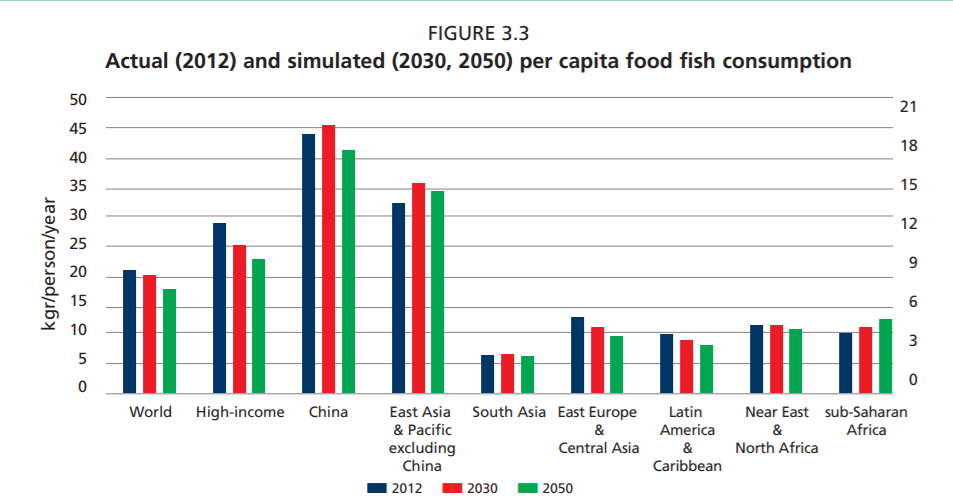
Figure 2: Recent (2012) and simulated (2030,2050) per capita food fish consumption (Barange, et al., 2018)
Per capita fish demand is predicted to decrease by 0.6% between 2012 and 2030 for the high-income countries.
In low-and middle-income countries food fish consumption is expected to increase between 2012 and 2030. China, as well as East Asia and the Pacific, are expected to increase their food fish intake the most when compared to the rest of the world.
As a result, per capita, food fish consumption is expected to drop during this period in all regions between four percent (in East Asia and Pacific excluding China) and 14 percent (in Eastern Europe and Central Asia) with the exception of sub-Saharan Africa.
Countries with most endangered fish species
Fish are among the most endangered species group of animals on the planet. The figure below shows that sea species are threatened in most of the countries in the world.
The United States, India, Mexico, Tanzania, and Indonesia are the top five countries with the most threatened species of fish (bank, What are the countries with the most threatened species of fish? , 2018).
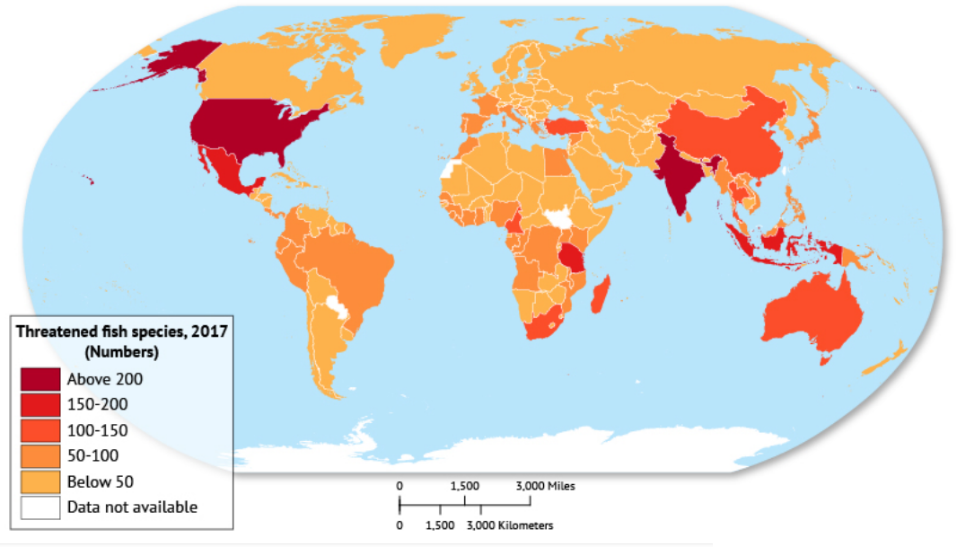
Figure 3: Threatened species of fish (World bank, 2018)
3. What is overfishing
According to WWF, overfishing can be defined as the practice of fishing whether it is commercial or non-commercial, in rivers, streams, and oceans at a too high rate where fish stocks become too depleted to recover naturally.
For a sustaining life on our planet, aquatic creatures and overall health and safety of marine life is crucial (Rinkesh, 2020).
Overfishing is causing dreadful consequences that affect the balance of life in the oceans as well as the social and economic well-being of Humans who mostly depend on fish for their way of life (Rinkesh, 2020). Today, 19.2 Kg of fish is consumed per each person every year, around twice as much as 50 years ago (FAO, 2014).
Thus, in 2018, around 6 billion tons of fish and other invertebrates were caught from the seas worldwide, which means 30 to 35% of the marine population were overfished with 60% fully fished based on the latest available data. (FAO, 2018).
Many seas and oceans around the world are subject to unsustainable fishing practices including 40% of fish stocks in the North-East Atlantic and 87% in the Mediterranean and Black Seas (STECF, 2019).
As a result of prolonged and widespread overfishing, nearly a third of the world’s assessed fisheries are now in deep trouble, making the fishing industry the main threat to marine wildlife.
However, due to early well-managed fisheries, some northern European fish stocks are getting better and are at their maximum sustainable yields like those in the Norwegian Sea and Barents Sea (Froese et al., 2018).
4. Climate change impacts on ocean aquatic life
Environmental variability and long-term climate change have a great influence on the ecosystems and the food production systems (Ray, 2015).
Climate change and overfishing are playing an important role in accelerating the decline of ocean health putting marine ecosystems and the goods and services provided to society at risk.
Fisheries interact with climate change and biodiversity, leading to profound changes in ecosystem structure and function. Actually, Climate change is disrupting the physics, chemistry and ecology of the ocean, with significant consequences on the life it holds. (Rashid & Travis, 2020).
Wild fisheries catch, particularly for small-bodied pelagic, show large inter-annual fluctuations with climate (Jillian P.Fry, et al., 2016).
The figure below shows how climate change impacts fisheries and marine ecosystems and life through a number of channels.

Figure 4: impacts of climate change on fisheries and ecosystems and life (Tim. M Daw, et al. 2009)
Climate change can directly affect marine life by changing the physiological function and behavior of the aquatic animals (Somero, 2012).
- Changing in Water Temperature
Global warming affects the Temperature of the oceans which in turn affects the biological performance of marine organisms including growth, reproduction, and survival.
Climate can influence the timing of seasonal biological events. For example, juvenile Atlantic salmon migration was observed (Otero et al., 2014), and general widespread ecosystem shifts across all major taxonomic groups in the United Kingdom (Thackeray et al., 2010)
- Changing in oxygen content
Dissolved oxygen plays a crucial role on the global carbon and nitrogen cycles in aquatic systems. So, a change in DO concentration influences greatly the biological and biogeochemical processes.
The onset of rapid climate-related changes in these ecosystems are increasing pressure on fish stocks, with the potential of extinction for some fish species.
5. Causes of Overfishing
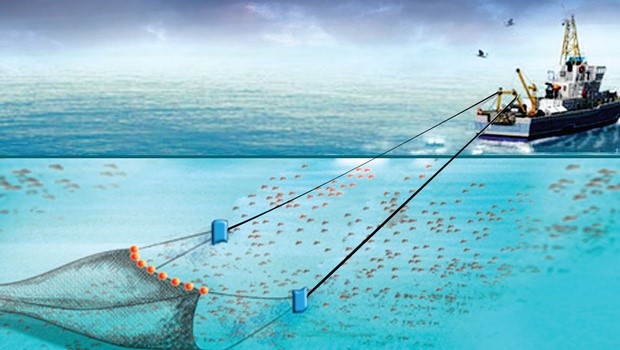
Source: Daily News, 2017
Some of the causes of overfishing include:
- Overcapacity
The modern equipment and technology that fishing industries use can deploy deep into the oceans and can stay on the seas for weeks and months (Today, 2008).
- Unsustainable Fishing
Unsustainable fishing encompasses the use of nets, fishing methods such as bottom trawling and pelagic driftnets, that catch too many fish to a degree that they are endangered.
It also involves catching other sea animals other than fish in the process. These are called By-catch. In many cases, by-catch is destroyed and thrown back into the sea. They also catch young fishes and prevent them from growing to reproduce.
- Illegal and Unregulated Fishing Activities
Illegal fishing activities include poaching, taking more than the allowed amount of catch, and fishing out of season. According to WWF, illegal fishing accounts for about 20 percent of the world’s catch and up to 50 percent in some fisheries.
- Economic and Food Needs
The demand of humans for food and fish has increased which makes the fishing industries forced to catch more fish to meet the needs of consumers. That, with the economic ambitions of fishing industries result in overfishing.
- Poor Fisheries Management
Lack of management and proper government fisheries rules and regulations are a key cause of overfishing. The rules and regulations we have today have proven to be ineffective when it comes to limiting fishing capacity to sustainable levels.
Current key management problems include:
- Lack of implementation/enforcement;
- Lack of transparency and traceability;
- Failure to follow scientific advice.
6. Effects of Overfishing
Besides the effects on human consumption, overfishing can have a number of other effects:
- Ecosystem destruction and imbalance
Unsustainable fishing or the use of modern fishing technology is a major threat to ocean ecosystems. Three main issues that current fishing technology can cause: The destruction of the physical environments of marine life, ghost fishing and bycatch.
Additionally, the catching of essential predators such as sharks, tuna, and billfish in long run disrupt the marine ecosystem. This can affect the rest of the ecosystem, with issues such as the increased growth of algae.
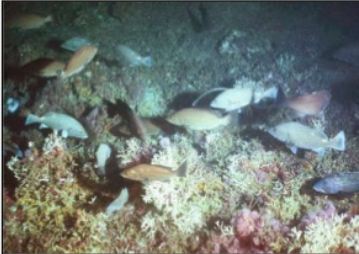
Before trawling
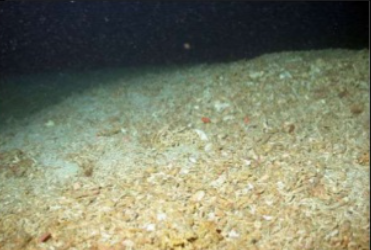
After trawling
Figure 5: Example of habitat destruction in the deep-sea Oculina coral reefs of Florida’s Atlantic Coast (Lance Horn & Gilmore, 2005)
- Socio-economic Impact
Many people around the world relay on fishing for their livelihood and nutritional needs. Oceans have supplied us with sufficient seafood for years, but that is no longer the case.
So, when these peoples can’t access food or their financial support, they are likely to have trouble in the future. In addition, with no valuable fish left in the waters to fish, the fishing industry is on the verge of collapse.
- Rise of the Endangered Species
Oceans have a rich and diversified marine life with millions of fish species and other marine animals.
Fishing a very particular species may lead to their extinction. Actually, 5 out of the 8 tuna species are at risk of extinction according to the International Union for Conservation of Nature (IUCN).
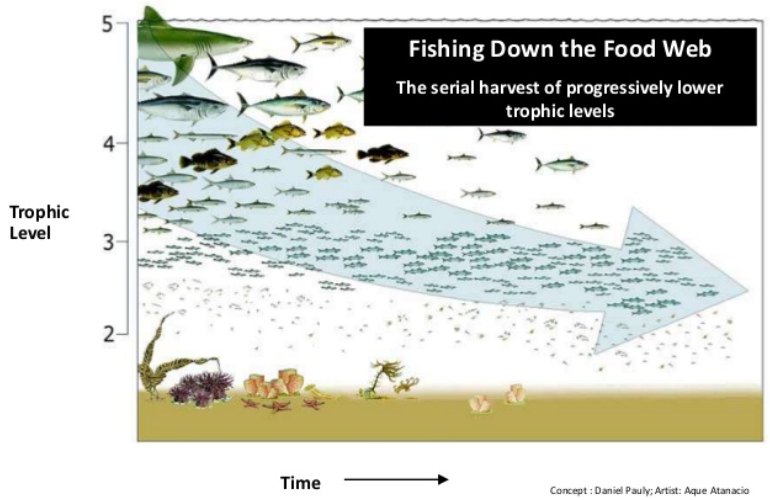
Figure 6: Less diversified fish species (Pauly D, 1998)
- Pollution
Oil and liquid spills, chemical, and solid elements discharged into the water by fishing boats, vessels and trawlers often hurt marine life. Water pollution has very devastating consequences.
- Improper Aquaculture
In order to be able to reinforce proper ecological balance in the water bodies, it is essential that the fisheries are equipped with not just the proper instruments but also the proper scientific knowledge to be able to practice proper aquaculture. Due to this lack of proper scientific knowledge, the aquaculture practices are vastly improper.
7. Mediterranean Sea: World’s most overfished
The Mediterranean Sea has high biodiversity that makes it is one of the world’s biodiversity hotspots. It has more than 17,000 marine species (Coll et al., 2010).
The map below shows the biodiversity of The Mediterranean Sea (Coll et al., 2010).

Starting from 1970s, overfishing began in the Mediterranean Sea and caused a high percentage of unsustainably harvested fish populations.
As a result of that, 90 percent of its fish populations is exploited in excess and makes the Mediterranean the world’s most overfished sea.
According to the International Union for Conservation of Nature (IUCN), more than 50% of the sharks and rays native to the Mediterranean Sea are at a high risk of extinction (Dasgupta, 2016).

Most local extinctions of sharks and rays have occurred in the North West Mediterranean waters. Photo: IUCN-Med.
8. Solutions to end overfishing
- Create more marine protected areas
Nowadays, the protected areas from marine parks are less than 2% and the areas protected from any kind of fishing are less than 1%.

Figure 7: Areas under some form of protection in 2020 (WWW.PROTECTEDPLANET.NET/UNEP-WCMC, 2020)
More no-catch zones must be established to allow fish populations and their ecosystems to recover and to ensure fishing for future generations.
- Establish catch shares
To manage fishing, establishing catch share is an important way. It gives a specific portion of the year’s overall catch limit to individual fishermen, or a group of fishermen, for their exclusive use. This way, there will be no competition among the fishermen like in the traditional fisheries management system.
Catch shares commonly give more security to fishermen, allowing them to catch their portion when they want to. Most of all, catch shares use a total allowable catch for a species depending on numbers that scientists believe allow the fishery to recover.
- Ban the illegal practice
The illegal fishing is practiced by persons which their only want is to earn high profit. These practices leave chaos to the ocean life.
The unregistered fishing companies and the foreign fishing vessels are in charge for this illegal practice. They do not follow the rules and run their practice undercover. Combating this crime will help the fisheries develop and keep the fish stock in allowable levels.
- No more trawling
Trawling drags huge nets through the ocean that swipe every marine creature in their pathway, resulting in massive wasteful by-catch. Banning the trawling will save more life and the number of caught fish can always stay under control without any wasted marine life.
- Use of sophisticated technology for fishing
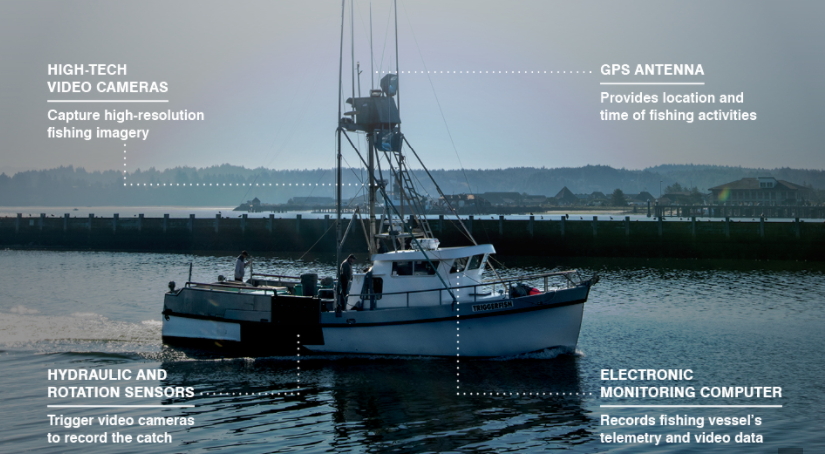
Figure 8: High-tech future of fishing (EDF, 2020).
Improving the fishery management by equipping boats with powerful digital tools could add more jobs, more than $80 billion to the global economy and could reverse the biggest threat to our oceans — overfishing (EDF, 2020).
Adding advanced technology makes management, and fishing itself, more efficient. Fishermen boost profits, while protecting marine ecosystems.
- Individual Consumer awareness
As global citizens become more aware of overfishing and the ecological destruction of the oceans, movements have sprung up to encourage abstinence.
- Do not eat any seafood—or eat only “sustainable seafood” (Monbiot, 2019).
- Avoid big fish, which have been overfished for years, like marlin, tuna and shark.
- Eat small fish – 90% of the big fish are gone, they’re important for the ecosystems, and they’re also very often full of toxic contaminants like lead.
- Use seafood guides such as the Seachoice and Seafood Watch pocket guides, iPhone or Android app to make good seafood choices at the grocery store or restaurant.
References
World bank, W. (2018, June 13). What are the countries with the most threatened species of fish? Retrieved from Maps of World: https://www.mapsofworld.com/answers/world/countries-threatened-species-fish/#
Barange, M., Bahri, T., Beveridge, M., Cochrane, K., Funge-Smith, S., & Poulain, F. (2018). Impacts of climate change on fisheries and aquaculture : synthesis of current knowledge adaptation and mitigation options. Rome: FAO Fisheries and Aquaculture Technical Paper.
Dasgupta, S. (2016, December 06). Over 50% of sharks and rays in the Mediterranean Sea are at risk of extinction. Retrieved from Mongabay: https://news.mongabay.com/2016/12/over-50-of-sharks-and-rays-in-the-mediterranean-sea-are-at-risk-of-extinction/
David Marinell. (2018, March 29). Oceans Without Fish by 2048, Extinction Happening Now. Retrieved from Save Earth World: https://www.davidmarinelli.net/blog/oceans-without-fish-2048-extinction/
Daw, T. Adger. N., Brown. K., & Badjeck. M.C. (2009). Climate change and capture fisheries. Climate change implications for fisheries and aquaculture. Overview of current scientific knowledge. FAO FISHERIES AND AQUACULTURE TECHNICAL PAPER.
EDF (2020). This is the high-tech future of fishing. Retrieved from EDF 5Environmental defence fund): https://www.edf.org/oceans/high-tech-future-fishing
FAO (2018). The State of World Fisheries and Aquaculture . Rome: Meeting the sustainable development goals FAO.
FAO, & F. a. (2020). The state of world fisheries and aquaculture. Ghana: FAO.
(2014). Food and Agriculture Organization of the United Nations (FAO) . Rome: The State of World Fisheries and Aquaculture .
Froese, R. W. (2018). Status and rebuilding of European fisheries. Mar. Policy 93, 159–170. doi:10.1016/j.marpol.2018.04.018
J.L. Blanchard, R. A.-B. (2017). Linked sustainability challenges and trade-offs among fisheries, aquaculture and agriculture. Nat. Ecol. Evo., 1 , 1240-1249.
Jillian P.Fry, D. C., Graham K., Paul C., M.Engstrom, Keeve E., & S.Lawrence. (2016). Environmental health impacts of feeding crops to farmed fish. Environ. Int. 91, 201–214.
Lance Horn, & Gilmore, G. (2005). National Undersea Research Center. University of North Carolina. TerraNature.
Marta Coll, C. P. (2010). The Biodiversity of the Mediterranean Sea: Estimates, Patterns, and Threats. PLOS_ONE_Group. doi:doi.org/10.1371/journal.pone.0011842
Marwaha, N, Malcolm, Beveridge, C. M., Michael, a., & Phillips, J. (2020). Alternative seafood: Assessing food, nutrition and livelihood futures. WorldFish.
Monbiot, G. (2019). Stop eating fish. It’s the only way to save the life in our seas. The Guardian.
News, D. (2017, July 06). New Bill to curb illegal fishing methods. Retrieved from Daily News.
Otero, J. L.-L.-S. (2014). Basin-scale phenology and effects of climate variability on global timing of initial seaward migration of Atlantic salmon (Salmo salar). Glob. Chang. Biol. 20, 61–75. doi: 10.1111/gcb.12363
Pauly D, C. V. (1998). Fishing down marine food webs. Science 279, 860−863.
Rashid, S., & Travis, C. (2020, July 15). End Overfishing and Increase the Resilience of the Ocean to Climate Change. Retrieved from Frontires in Marine Science: https://www.frontiersin.org/articles/10.3389/fmars.2020.00523/full#:~:text=%2D%20Climate%20change%20is%20having%20significant,likely%20to%20survive%20when%20healthy
Ray, D. K. (2015). Climate variation explains a third of global crop yield variability. Nat. Commun. 6, 5989.
Rinkesh. (2020). What is overfishing . Retrieved from Conserve energy future: https://www.conserve-energy-future.com/causes-effects-solutions-of-overfishing.php
Somero, G. N. (2012). The physiology of global change?: linking patterns to mechanisms. Ann. Rev. Mar. Sci. 4, 39–61. doi:10.1146/annurev-marine-120710-100935
STECF, T. (2019). Monitoring the Performance of the Common Fisheries Policy (STECF-Adhoc-19-01). Luxembourg: Publications Office of the European Union.
Thackeray, S. J. (2010). Trophic level asynchrony in rates of phenological change for marine, freshwater and terrestrial environments. Glob. Chang. Biol. 16, 3304–3313.
Today, e. (2008). eSchool Today. Retrieved from How does overfishing happen?: https://eschooltoday.com/learn/what-causes-overfishing/
YPTE, P. (2020). Overfishing. Retrieved from Young People’s Trust For the Environment: https://ypte.org.uk/factsheets/overfishing/introduction#section4